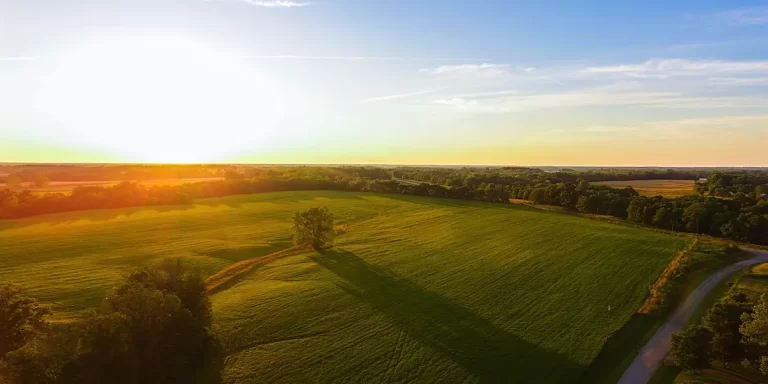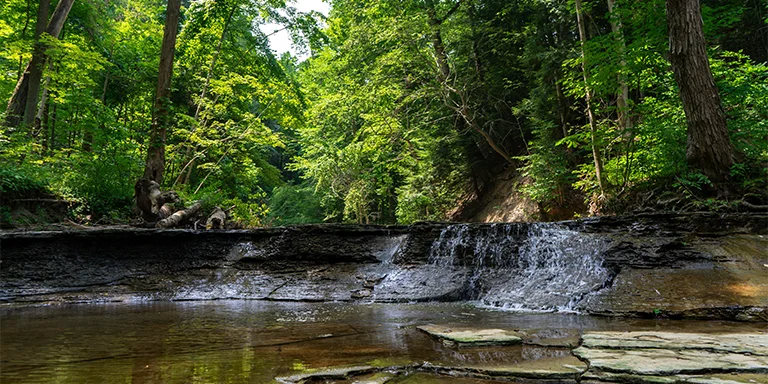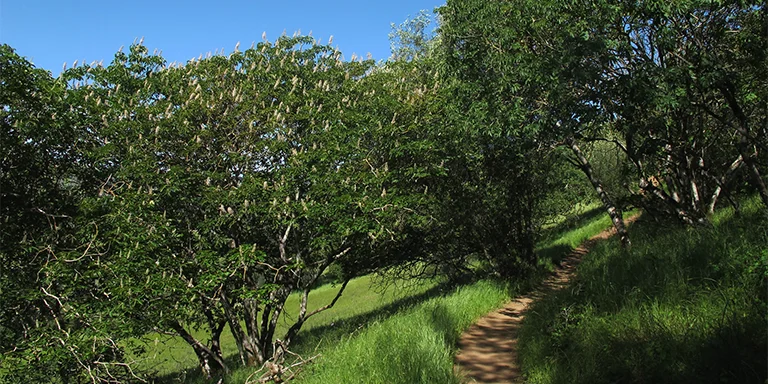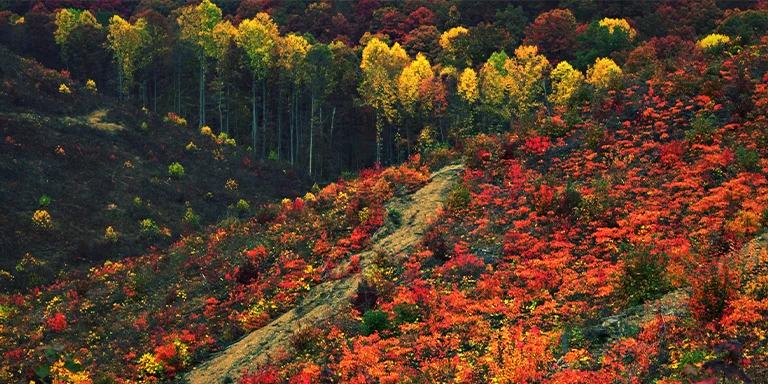

Backpacking in Ohio offers surprising diversity for outdoor enthusiasts, from the rolling hills and forests of Hocking Hills to the Lake Erie coastline, including popular destinations like Cuyahoga Valley National Park.
And that’s what this post is all about – backpacking in Ohio. We’ll provide tips to help you prepare for backpacking in this varied state as well as showcase the TOP 5 multi-day trails in Ohio.
Interested? Let’s get started.
Explore Ohio’s best backpacking trails, suitable for all skill levels:

Heath Cajandig, CC BY 2.0, via flickr
Length: 21.2 mi / 34.1 km
Type: Loop
Difficulty: Moderate
Elevation Gain: 1715 ft / 522.7 m
Location: Burr Oak State Park
Estimated Hiking Calorie Burn: 4000 calories
More Details: See on AllTrails
The Buckeye Trail is a popular 21-mile loop near Glouster, Ohio, offering a moderately challenging 8-hour hike best done April through October. It’s great for backpacking, birding, camping, and enjoying solitude on this well-maintained trail with clear signage and beautiful lake views. You can camp across the lake to split the hike almost in half. Be prepared with enough water, food, and bug protection.

Wayne National Forest, CC BY 2.0, via Wikimedia Commons
Length: 14 mi / 22.5 km
Type: Loop
Difficulty: Hard
Elevation Gain: 2014 ft / 613.9 m
Location: Wayne National Forest
Estimated Hiking Calorie Burn: 2700 calories
More Details: See on AllTrails
The challenging 14-mile loop near New Matamoras is great for backpacking, camping, and hiking March-October. Highlights are the awe-inspiring Natural Bridge, Cave, and giant rock outcroppings along the well-marked trail with yellow diamonds. Watch for trip hazards like leaves and roots. Campsites available after an initial climb. Gorgeous scenery with solitude on quieter days. Moderately difficult with manageable switchbacks.

Length: 73.3 mi / 118 km
Type: Point to point
Difficulty: Moderate
Elevation Gain: 5029 ft / 1533 m
Location: Mentor
Estimated Hiking Calorie Burn: 14 300 calories
More Details: See on AllTrails
Backpackers and hikers will enjoy the moderately challenging 73-mile trek from Brecksville to Headlands Beach State Park, ideal from March through October. Following the Towpath Trail through Cuyahoga Valley National Park, it then winds through various Cleveland Metropark and Lake Metropark reservations. Some road walking is required, but nice footpaths through forests and meadows offer great scenery too. Highlights include spotting nesting eagles at Mentor Marsh, scenic overlooks of Cleveland, and finishing at the lake. While well-marked, be prepared for potential wet and muddy conditions.

Josh*m, CC BY 2.0, via flickr
Length: 57.5 mi / 92.5 km
Type: Point to point
Difficulty: Moderate
Elevation Gain: 498 ft / 151.8 m
Location: Clyde
Estimated Hiking Calorie Burn: 10 800 calories
More Details: See on AllTrails
For a pleasant Midwestern adventure, try the moderately challenging 58-mile hike from Waterville to Clyde, best from March-October. It passes through farm country on rural roads and streams. Charming villages like Pemberville and Woodville lead to the North Coast Inland Trail into Fremont, with a stop at Rutherford B. Hayes Presidential Center. The trail ends in Clyde after flat yet scenic terrain, but watch for deep drainage ditches. This relatively secluded hike showcases classic rural Americana, ideal for lazy summer or crisp autumn days.

Alvin Feng, CC BY 2.0, via flickr
Length: 21.2 mi / 34.1 km
Type: Point to point
Difficulty: Hard
Elevation Gain: 3628 ft / 1106 m
Location: Shawnee State Park
Estimated Hiking Calorie Burn: 5200 calories
More Details: See on AllTrails
Experienced and very fit adventurers will relish this challenging 21-mile trail near Friendship, best tackled April through October. Be prepared for overgrown brush, downed trees, and stream crossings without bridges along the steep, rugged terrain with few views. Campsites are sparse but offer solitude. Changing weather, ticks, and lack of access for help are additional challenges. Highlights include the lovely Camp 6 by the water and rare old growth pine/spruce areas. Overall, it provides an intense, secluded backpacking experience.
Ohio witnesses a varied climate characterized by four distinct seasons:
Before choosing your gear and hitting the trail, check Ohio’s (Columbus) annual weather averages:
| Jan | Feb | Mar | Apr | May | Jun | Jul | Aug | Sep | Oct | Nov | Dec | |
|---|---|---|---|---|---|---|---|---|---|---|---|---|
| High °F | 37 | 41 | 52 | 64 | 73 | 81 | 84 | 83 | 76 | 65 | 52 | 41 |
| Low °F | 24 | 26 | 34 | 44 | 54 | 62 | 66 | 64 | 57 | 46 | 37 | 28 |
| Rain/Snow (D*) | 7 | 7 | 9 | 10 | 12 | 12 | 11 | 9 | 8 | 7 | 7 | 7 |
Not sure if Ohio is right for you?
Don’t forget to check out our backpacking guides for Indiana and Michigan.
You can have campfires in designated backcountry campsites in many Ohio public lands, but check the rules for each place before your trip. Usually, fires must be in established fire rings or pits, and there might be total fire bans during dry conditions.
When backpacking in Ohio, be ready for lots of rain and muddy trails by bringing good wet weather gear, waterproof shoes, and trekking poles for stability. Plan your route ahead, use a GPS or maps, and know how to navigate in dense forests to avoid getting lost. Follow camping rules and store food safely to reduce the chance of encounters with black bears in some places. Be cautious of snakes near water and bushes—stay on trails and avoid reaching into openings. Check for ticks every day and be aware of the signs of Lyme disease if bitten. If hiking alone, share your trip plans and schedule check-ins with someone.
If you run into wildlife in Ohio, it’s best to stay back and not bother them. Give space to bigger animals like deer or coyotes. If you see black bears or bobcats, back away slowly. Try to avoid snakes, but if you come across one, stay calm, be still, and carefully move around it. Never feed or get close to wild animals. Follow food storage rules at campsites. If an animal seems aggressive, make noise and look big. Also, know how to deal with common critters like ticks and mosquitoes.
Choose lightweight backpacking gear like a tent, sleeping bag, and backpack designed for multi-day trips. Bring essentials like a map, compass, first aid kit, and water purification supplies. Pack layers of clothing for changing weather and broken-in hiking boots. Get necessary permits and review leave no trace ethics. Study maps to plan a route exploring forests, rivers, or hills. Ensure adequate fitness for carrying a heavy pack over varied terrain. Pack enough food that is lightweight, nutritious and easy to prepare on a camp stove. Find water sources for refilling along the route. Charge electronics like a flashlight and phone before going and bring a power bank to charge when possible on the trail. Enjoy immersing yourself in nature while backpacking responsibly.